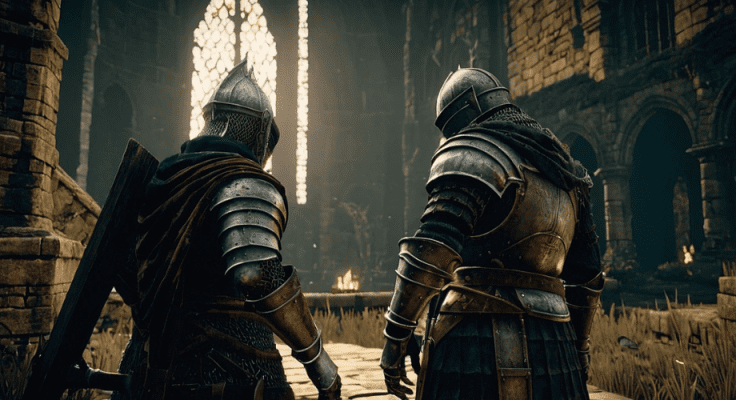Exploring the Depths of Dark Souls: Understanding Its Lore and Unique Difficulty
- Grace Lee
- 30 Dec, 24

From the moment I stepped into the world of Dark Souls, I was captivated. The haunting atmosphere, the foreboding landscapes, and the intricate level design drew me in like a moth to a flame. There’s an undeniable appeal in traversing a realm where danger lurks around every corner and the stakes are life and death, not just in gameplay, but within the rich lore that envelops the game. This is no ordinary video game; this is a journey into darkness, filled with stories waiting to be unraveled.
A Disjointed but Intricate Narrative
The narrative structure of Dark Souls is unlike anything I’ve encountered before. It doesn’t spoon-feed information; instead, it presents pieces of a fragmented story that demands the player's attention and curiosity. The scattered lore is embedded in item descriptions, character dialogues, and the world itself. Each encounter with a boss or NPC evokes a story that intertwines with the history of Lordran, leading me to connect dots that form a bigger picture of despair and struggle.
The Unseen History of Lordran
As I progressed, I learned about the Age of Fire and the Age of Dark, a perpetual cycle that tormented the land and its inhabitants. The gods, mythical beings, and the primordial serpent, all played pivotal roles in shaping this world. It's almost poetic how the history is layered, with each character representing a facet of the world’s tragedy. Learning about Gwyn, the Lord of Sunlight, and his sacrificial choice to prolong the Age of Fire sent chills down my spine, compelling me to question the morality behind every action.
Narrative through Environment
The environments also narrate their own stories. As I traversed through the dilapidated ruins of the Undead Burg, the somber echoes of fallen warriors whispered the remnants of their lives. The broken remnants of the past become an integral aspect of understanding the lore. Each area resonates with a feeling of decay, hinting at the catastrophic events that led to the present state of the world, intertwining gameplay and storytelling in a seamless manner.
Characters Who Matter
Each character I encountered felt essential and carefully crafted. From the enigmatic figure of Shiva of the East to the heart-wrenching story of Solaire, I found myself emotionally attached to many of them. The motivations of these characters, steeped in their own tragedies and aspirations, further fleshed out the complex ambition that Dark Souls has to offer. Discovering their backstories made every encounter feel impactful, blurring the lines between ally and enemy.
The Difficulty as a Narrative Device
The notorious difficulty of Dark Souls serves a purpose beyond mere gameplay challenge. Each death, every failed attempt to defeat a boss, felt like a necessary part of the narrative. The brutal nature of the game drove home the themes of perseverance and consequence. It made every victory taste sweeter, imbued with hard-won lessons. Dying became an integral part of growth rather than a setback, and that shift in perspective reshaped how I viewed challenges both in-game and in broader contexts.
The Combat: A Dance of Precision
When I engaged in combat, it felt more like a dance than a fight. Every strike, dodge, and block had to be meticulously planned. The critical timing made the world feel alive; every enemy encounter required acute awareness. The satisfying, visceral feedback from defeating foes I had previously struggled against created an intoxicating loop of challenge and reward that became irresistible. The combat mechanics compelled me to learn, adapt, and evolve with every encounter.
Embracing the Challenge
At first, the difficulty intimidated me. Every encounter felt insurmountable, a wall that I could not scale. Yet, gradually, I began to embrace that challenge. The exhilaration of finally defeating a boss after countless attempts is an emotion unrivaled in gaming. Every slight improvement in my skill was an affirmation of my dedication. The sense of achievement tied to each victory elevated the experience, allowing me to appreciate the journey, not just the destination.
The Role of Darkness
The overarching theme of darkness infused every corner of Dark Souls, manifesting not only in the aesthetics but in its lore and gameplay. The presence of the Abyss, a dark force that threatens to swallow everything, constantly reminds me that light and hope are fleeting in this world. Yet, despite the bleakness, there are glimmers of hope from facing adversity. This dichotomy added layers of depth, allowing me to delve into my perceptions of struggle and light, both in-game and in reality.
The Importance of Community
In a game laden with loneliness, the community surrounding Dark Souls flourished like a beacon of light amidst the darkness. Through forums, wikis, and gameplay videos, I discovered shared experiences and interpretations of the lore. The excitement of sharing triumphs or strategizing methods to overcome challenging bosses with fellow players is irreplaceable. I valued the insights gained from others, enriching my own understanding of the game's intricate world.
The Estus Flask: A Symbol of Hope
The Estus Flask became a symbol of hope throughout my journey. Each sip represented rejuvenation and was a reminder that despite the overwhelming odds, I possessed the means to forge ahead. It was a lifeline in the oppressive atmosphere of despair. The limited number of flasks I could use became a source of anxiety, but they also encouraged strategic thinking. Balancing risk and reward became essential, as I navigated through enemy-laden environments.
Fellow Undead: Finding Companionship
Though Dark Souls offers a solitary experience, I found companionship in phantoms. It was enchanting to summon willing players to assist me in battles against overwhelming foes. This cooperative aspect, fleeting yet impactful, allowed me to connect with others briefly while sharing the burden of a challenging world. In those moments, the experience felt less daunting, a shared trial uniting us against common struggles.
The Power of Choice
Character creation was a significant part of my immersion. I meticulously customized my character’s appearance and began to shape my own journey. The choices I made in developing my character's skills and weapons echoed in my approach to different situations throughout the game. Each decision felt monumental, giving me agency in a narrative riddled with predestined tragedies. This player agency became a cornerstone as I forged my path through the unforgiving world.
Lessons from Failure
Throughout my journey, failure became my greatest teacher. Every defeat, every frustrating moment, imparted a lesson that shaped my understanding of the game. I learned to analyze enemy movements, adapt strategies, and manage my resources wisely. Embracing failure as a part of the journey rather than an endpoint is a lesson that transcends the game, teaching me the value of resilience and perseverance.
Rediscovering the Joy of Exploration
Scouring the hidden corners of Dark Souls was a genuine joy. Discovering secret paths, hidden items, and lore-rich areas heightened my sense of exploration and adventure. The world felt alive, with its secrets waiting to be uncovered. Each hidden area expanded my understanding of the game’s lore while presenting new challenges—a rewarding cycle that kept my curiosity alive.
Culmination of Experience
As I approach the end of my journey in Dark Souls, I can’t help but reflect on the experiences that have shaped my understanding of its unique difficulty and rich lore. The game is an intricate tapestry woven with themes of light and darkness, triumph and despair, perfectly embodied in its challenging gameplay and profound narrative. With every encounter, every revelation, I've immersed myself in a world that has left an indelible mark on my soul.












